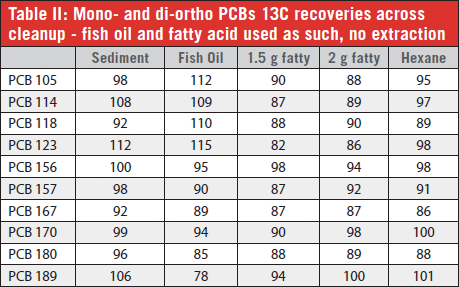A Low Solvent Extraction and Cleanup for POPs Analysis
The Application Notebook
Persistent organic pollutants (POPs) such as polychlorinated dibenzo-p-dioxins (PCDDs), furans (PCDFs), and biphenyls (PCBs) around the world have strict regulations in force in many countries. Rapid extraction, sample cleanup, and analysis are needed for many laboratories processing samples for POPs.
A newly developed automated sample extraction and cleanup system allows for rapid extraction of the sample (time approximately one hour) and fast cleanup (two hours). Solvent consumption is limited to 120–200 mL and no dichloromethane is used during the cleanup step. The fully automated system allows for sample turnaround times of only a few hours and same day analysis and results.
Analytical Instrumentation
- DFS HRMS
- TSQ Quantum XLS TripleQuad MS
Consumables
- FMS, Inc. High Capacity Acid-Base-Neutral Silica column
- FMS, Inc. Mini Acid-Base-Neutral Silica column
- FMS, Inc. Mini Basic Alumina column
- FMS, Inc. Carbon column

Pressurized Liquid Extraction
- 1–2 g of sediment or feed mixed with 10 g inert Hydro-matrix®
- Sample placed in extraction cell
- Heated with 50% dichloromethane/50% hexane for 20 min at 120 °C and 1500 psi
- Nitrogen and solvent flush to transfer analytes and extract to 250 mL collection tubes

SuperVap Concentration
- Pre-heat temperature: 45 °C
- Heat in Sensor mode: 45 °C
- Nitrogen Pressure: 6-8 psi
- Solvent exchange to hexane
EconoPrep Clean Up
- System uses order of columns: silica -carbon - alumina
- Uses only hexane and toluene for 5 step program
- Condition with hexane
- Load sample in hexane
- Elute silica column with hexane
- Elute carbon in reverse (upward) direction with toluene (collect PCDD/F and co-planary PCBs)
- Elute alumina in reverse direction with toluene (collect mono-ortho and di-ortho PCBs)
- Reduce sample to 10 μL final volume under 1–1.5 psi nitrogen at 25 °C
Conclusions
The integrated PLE/Low Solvent EconoPrep gives excellent recoveries for a number of matrices. It is a green option with low electrical power use. The system uses only a total volume of 120–200 mL of hexane and toluene and no dichloromethane for the cleanup step.

FMS, Inc.
580 Pleasant Street, Watertown, MA 02472
tel. (617) 393-2396, fax (617) 393-0194
Website: www.fms-inc.com












